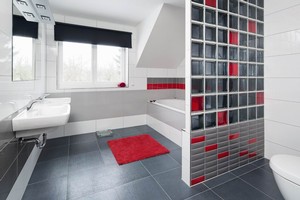Plasterboard structure tiles
 While applying tiles to dry assembled structures, caution must be exercised while dealing with their flexibility and material adaptability (in this case, ceramic tiles) in order to balance any movement within the structure. Therefore, we concentrate on conditioning the base and using flexible installation materials.
While applying tiles to dry assembled structures, caution must be exercised while dealing with their flexibility and material adaptability (in this case, ceramic tiles) in order to balance any movement within the structure. Therefore, we concentrate on conditioning the base and using flexible installation materials.
Type of structure
- PE 201, PE 202 primers
- SE 1 waterproofing screed
- SE 5 sealing tape with a min. width of 80 mm
- AD 510 PLUS or AD 509, AD 520, AD 530, AD 550 adhesive
- Ceramic tiles
- GF DRY flexible jointing material
- SI silicone sealant + PES polyethylene separator
Work procedure – detailed description
Preparation: The base must be rigid, cured, and free of any impurities and uneven spots.
Base priming: For plasterboard panels, their absorbency must be treated with a full strength PE 201 product. For extremely absorbent materials, use PE 202 at the required diluted ratio (approx. 1:3-5). Approx. 0.15-0.25 l/m2 of the product is needed.
Insulation – sealing all water-loaded rooms: See the bathroom system solutions.
Installation of ceramic wall and floor tiles on an insulation layer: Modified adhesive sealants must be used for wall and floor tile installations. For standard formats within our housing ceramic programme, we use C1TE grade AD 510 PLUS cement adhesive, or fully flexible AD 520, AD 530 adhesive. For reduced formats and mosaics, white C1TE grade AD 509 PLUS cement adhesive, or fully flexible AD 550 adhesive, may be used. Between 2 to 4 kg/m2 of adhesive is needed.
Ceramic shell jointing: For jointing, we use CG2 WA grade GF BIO or GF DRY flexible material. Thanks to special additives, use of these jointing materials increase the water repellent qualities of the system; GF BIO moreover offers protection against mould and efflorescence. This markedly increases the sanitary properties of the entire surface! Between approx. 0.3 and 0.8 kg/m2 of material is needed, depending on the format size of the tiles.
Sealing of flexible joints and passageways with permanently elastic sealant: Permanently elastic SI sealant must be used to allow expansion movement within the joint. The colour spectrum covers all colours available in the GF series. If SI material is applied, it is recommended that PES polyethylene separators are used. They will prevent undesired adhesion to the bottom of the joint and define the exact shape of the silicone filler. The spreading rate of the 310 ml cartridge is approx. 6-12 bm, depending on the size of the joint.
Cleaning: In order to remove any cement deposits, use the CL 802 cleaning agent. Once the surface is thoroughly cleaned, we recommend that full-surface priming be applied with CL 809.
Maintenance: For regular maintenance, use the CL 803 or 804 cleaning agent.







